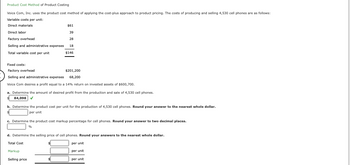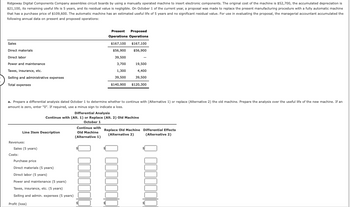
FINANCIAL ACCOUNTING
10th Edition
ISBN: 9781259964947
Author: Libby
Publisher: MCG
expand_more
expand_more
format_list_bulleted
Concept explainers
Question
Need help with this two part question. Thank you!

Transcribed Image Text:Product Cost Method of Product Costing
Voice Com, Inc. uses the product cost method of applying the cost-plus approach to product pricing. The costs of producing and selling 4,530 cell phones are as follows:
Variable costs per unit:
Direct materials
Direct labor
Factory overhead
Selling and administrative expenses
Total variable cost per unit
$61
39
28
18
$146
Fixed costs:
Factory overhead
$201,200
Selling and administrative expenses 68,200
Voice Com desires a profit equal to a 14% return on invested assets of $600,700.
a. Determine the amount of desired profit from the production and sale of 4,530 cell phones.
84,098
b. Determine the product cost per unit for the production of 4,530 cell phones. Round your answer to the nearest whole dollar.
per unit
c. Determine the product cost markup percentage for cell phones. Round your answer to two decimal places.
%
d. Determine the selling price of cell phones. Round your answers to the nearest whole dollar.
Total Cost
Markup
Selling price
per unit
per unit
per unit

Transcribed Image Text:Ridgeway Digital Components Company assembles circuit boards by using a manually operated machine to insert electronic components. The original cost of the machine is $52,700, the accumulated depreciation is
$21,100, its remaining useful life is 5 years, and its residual value is negligible. On October 1 of the current year, a proposal was made to replace the present manufacturing procedure with a fully automatic machine
that has a purchase price of $109,600. The automatic machine has an estimated useful life of 5 years and no significant residual value. For use in evaluating the proposal, the managerial accountant accumulated the
following annual data on present and proposed operations:
Sales
Direct materials
Direct labor
Power and maintenance
Taxes, insurance, etc.
Selling and administrative expenses
Total expenses
fan
a. Prepare a differential analysis dated October 1 to determine whether to continue with (Alternative 1) or replace (Alternative 2) the old machine. Prepare the analysis over the useful life of the new machine. If a
amount is zero, enter "0". If required, use a minus sign to indicate a loss.
Revenues:
Line Item Description
Sales (5 years)
Costs:
Differential Analysis
Continue with (Alt. 1) or Replace (Alt. 2) Old Machine
October 1
Purchase price
Direct materials (5 years)
Direct labor (5 years)
Power and maintenance (5 years)
Taxes, insurance, etc. (5 years)
Selling and admin. expenses (5 years)
Profit (loss)
Present Proposed
Operations Operations
$167,100 $167,100
$56,900 $56,900
39,500
3,700
19,500
1,300
4,400
39,500
39,500
$140,900 $120,300
-
$
Continue with Replace Old Machine Differential Effects
(Alternative 2)
Old Machine
(Alternative 2)
(Alternative 1)
Expert Solution
This question has been solved!
Explore an expertly crafted, step-by-step solution for a thorough understanding of key concepts.
This is a popular solution
Trending nowThis is a popular solution!
Step by stepSolved in 3 steps

Knowledge Booster
Learn more about
Need a deep-dive on the concept behind this application? Look no further. Learn more about this topic, accounting and related others by exploring similar questions and additional content below.Similar questions
- can i please get a correct answer for that questionarrow_forwardI need to know how to solve this exercise and what equation I should use Thank you!arrow_forwardMoving to another question will save this response. Question 2 A conceptual framework is like a A Moving to another question will save this responsearrow_forward
arrow_back_ios
SEE MORE QUESTIONS
arrow_forward_ios
Recommended textbooks for you

 AccountingAccountingISBN:9781337272094Author:WARREN, Carl S., Reeve, James M., Duchac, Jonathan E.Publisher:Cengage Learning,
AccountingAccountingISBN:9781337272094Author:WARREN, Carl S., Reeve, James M., Duchac, Jonathan E.Publisher:Cengage Learning, Accounting Information SystemsAccountingISBN:9781337619202Author:Hall, James A.Publisher:Cengage Learning,
Accounting Information SystemsAccountingISBN:9781337619202Author:Hall, James A.Publisher:Cengage Learning, Horngren's Cost Accounting: A Managerial Emphasis...AccountingISBN:9780134475585Author:Srikant M. Datar, Madhav V. RajanPublisher:PEARSON
Horngren's Cost Accounting: A Managerial Emphasis...AccountingISBN:9780134475585Author:Srikant M. Datar, Madhav V. RajanPublisher:PEARSON Intermediate AccountingAccountingISBN:9781259722660Author:J. David Spiceland, Mark W. Nelson, Wayne M ThomasPublisher:McGraw-Hill Education
Intermediate AccountingAccountingISBN:9781259722660Author:J. David Spiceland, Mark W. Nelson, Wayne M ThomasPublisher:McGraw-Hill Education Financial and Managerial AccountingAccountingISBN:9781259726705Author:John J Wild, Ken W. Shaw, Barbara Chiappetta Fundamental Accounting PrinciplesPublisher:McGraw-Hill Education
Financial and Managerial AccountingAccountingISBN:9781259726705Author:John J Wild, Ken W. Shaw, Barbara Chiappetta Fundamental Accounting PrinciplesPublisher:McGraw-Hill Education


Accounting
Accounting
ISBN:9781337272094
Author:WARREN, Carl S., Reeve, James M., Duchac, Jonathan E.
Publisher:Cengage Learning,

Accounting Information Systems
Accounting
ISBN:9781337619202
Author:Hall, James A.
Publisher:Cengage Learning,

Horngren's Cost Accounting: A Managerial Emphasis...
Accounting
ISBN:9780134475585
Author:Srikant M. Datar, Madhav V. Rajan
Publisher:PEARSON

Intermediate Accounting
Accounting
ISBN:9781259722660
Author:J. David Spiceland, Mark W. Nelson, Wayne M Thomas
Publisher:McGraw-Hill Education

Financial and Managerial Accounting
Accounting
ISBN:9781259726705
Author:John J Wild, Ken W. Shaw, Barbara Chiappetta Fundamental Accounting Principles
Publisher:McGraw-Hill Education